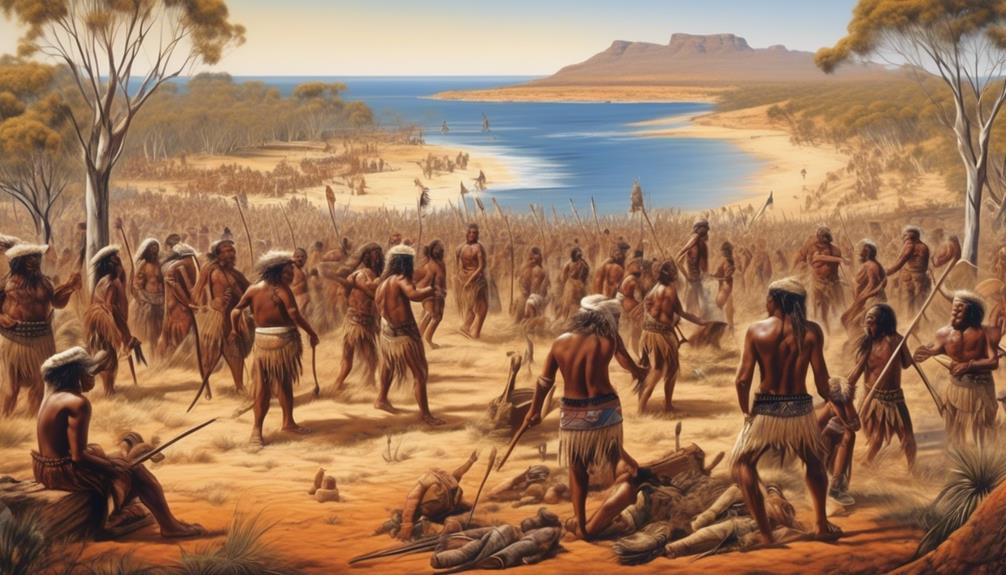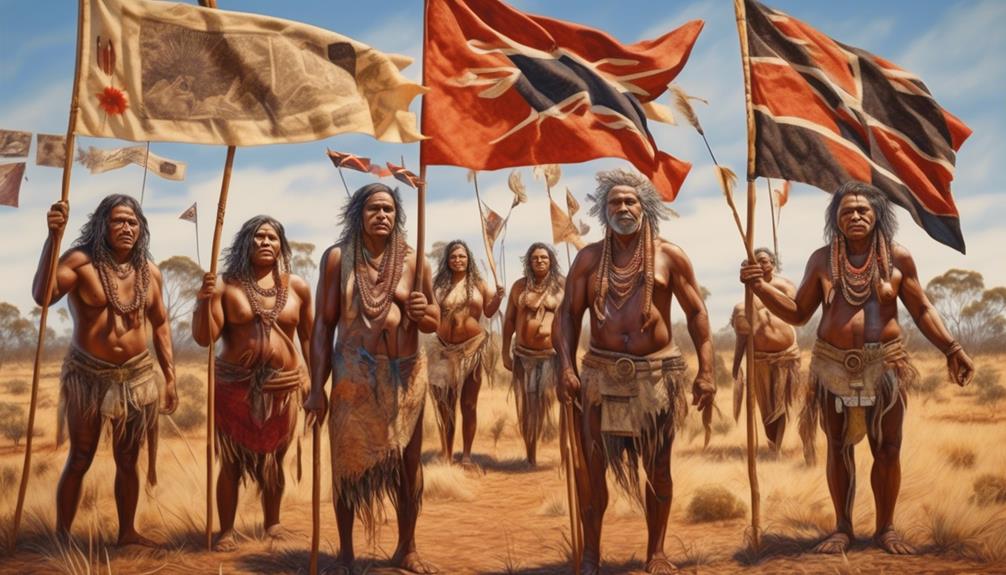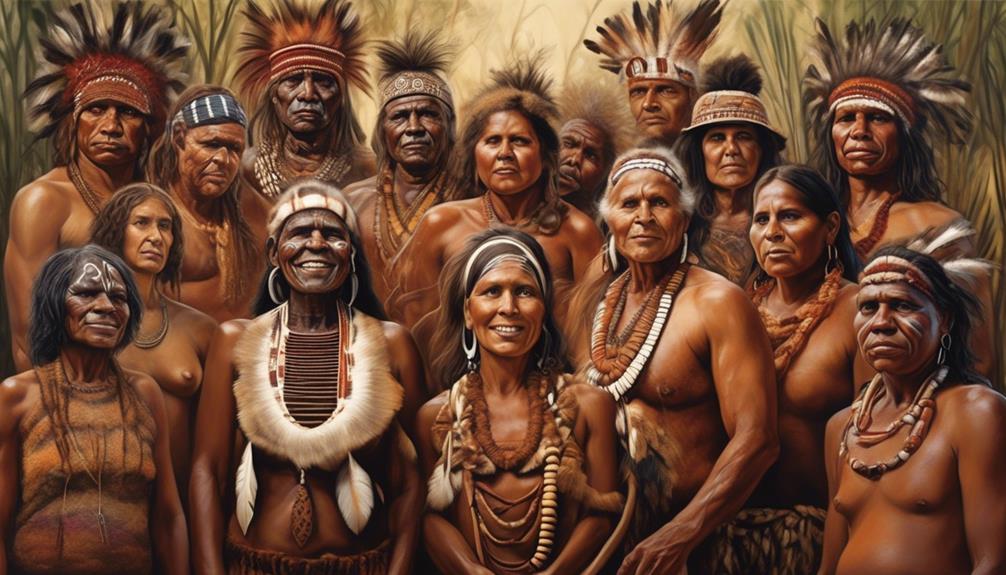Aboriginal
What Did Aboriginal Australians Eat During the Ice Age

During the Ice Age, Aboriginal Australians depended on a variety of food sources to survive the challenging environment. The inclusion of plant-based diets was crucial for their well-being, as a large assortment of indigenous fruits, seeds, and roots played a vital role in their nutrition.
However, their diet was not limited to plants alone, as they also had sophisticated hunting and gathering techniques that allowed them to procure animal protein. Understanding how Aboriginal Australians adapted to their environment and the specific food sources they relied on provides valuable insights into their resilience and resourcefulness in the face of challenging conditions.
Key Takeaways
- Aboriginal Australians relied on a diverse range of food sources during the Ice Age, including hunting large mammals, gathering edible plants, and exploiting marine resources.
- They utilized sophisticated hunting techniques, such as animal tracking and the use of various tools like spears, boomerangs, and fish hooks.
- Aboriginal Australians diversified their diet by incorporating a wide range of native plants through foraging techniques like digging for tubers and collecting seeds.
- They skillfully harvested marine resources, including shellfish and fish, enriching their diet with protein, minerals, and fatty acids.
Ice Age Environment and Food Sources
During the Ice Age, Aboriginal Australians relied on a diverse range of food sources, including hunting large mammals, gathering edible plants, and exploiting marine resources. Environmental adaptation played a crucial role in their survival. The harsh conditions of the Ice Age necessitated a deep understanding of the land and its resources.
Aboriginal Australians developed sophisticated food preservation techniques to ensure a stable food supply during times of scarcity. They used various methods such as smoking, drying, and preservation in honey or fat to store food for extended periods. This environmental adaptation allowed them to thrive in challenging conditions.
Furthermore, the utilization of different food sources highlights the resourcefulness of Aboriginal Australians. They not only hunted large mammals but also gathered a wide variety of edible plants, showcasing their deep knowledge of the environment. Additionally, the exploitation of marine resources provided a crucial supplement to their diet. This diverse approach to food procurement demonstrates their resilience and adaptability in the face of environmental challenges.
Understanding these historical practices can offer valuable insights into sustainable and adaptable food systems, serving as a source of inspiration for modern-day food security and environmental preservation efforts.
Hunting and Gathering Techniques

Utilizing a combination of sophisticated hunting techniques and extensive knowledge of the land, Aboriginal Australians demonstrated remarkable adaptability in procuring food during the Ice Age. Animal tracking was a crucial skill that allowed them to locate and hunt a diverse range of animals, including kangaroos, wallabies, and emus. By closely observing animal behavior and environmental cues, they could anticipate the movements of their prey, increasing the success of their hunts.
Additionally, tool making played a vital role in their hunting and gathering activities. Aboriginal Australians crafted a variety of tools such as spears, boomerangs, and fish hooks using materials readily available in their surroundings. These tools were meticulously designed to suit specific hunting purposes, reflecting their deep understanding of the behaviors and habitats of different animals.
Furthermore, the use of controlled burning to manipulate the landscape enabled Aboriginal Australians to drive animals towards waiting hunters, providing an effective strategy for capturing prey. This practice also promoted the growth of certain plant species, enhancing the overall availability of food resources.
Plant-Based Diet Diversity

Demonstrating a deep understanding of their environment, Aboriginal Australians diversified their diet by incorporating a wide range of native plants into their daily food sources. Foraging techniques were crucial in their plant-based diet diversity, as they utilized their extensive knowledge of the land to gather a variety of edible plants. By employing sophisticated foraging methods, such as digging for tubers, collecting seeds, and identifying seasonal fruits and vegetables, they were able to access a rich assortment of plant foods throughout the year.
The nutritional benefits of this diverse plant-based diet were significant. Aboriginal Australians consumed a wide array of nutrient-dense plants, including fruits, seeds, nuts, roots, and leaves, providing them with essential vitamins, minerals, and dietary fiber. This varied plant intake contributed to their overall health and well-being, offering a balanced and sustainable source of sustenance.
Their deep connection to the land and its natural resources enabled them to maintain a diet that wasn't only diverse but also nourishing, reflecting a profound understanding of the nutritional value present in their environment.
Utilization of Marine Resources

Aboriginal Australians skillfully harvested a diverse array of marine resources to supplement their diet and sustain their communities throughout the changing seasons. Marine foraging played a significant role in their food procurement strategies, providing essential nutrients and contributing to the overall resilience of their diet.
Shellfish consumption, in particular, was a key component of their marine resource utilization. The abundant coastal waters offered a variety of shellfish, such as oysters, mussels, and clams, which were carefully gathered and incorporated into their meals. These shellfish not only provided a good source of protein but also offered vital minerals and fatty acids, contributing to a well-rounded and nutritionally balanced diet.
Additionally, the skillful practice of fishing enabled Aboriginal Australians to access a wide range of fish species, further enriching their diet with valuable proteins and omega-3 fatty acids.
The utilization of marine resources reflected the deep understanding of the environment and the sustainable practices employed by Aboriginal Australians, highlighting their resourcefulness and adaptability in utilizing the natural bounty available to them.
Cultural and Ritualistic Food Practices
Cultural and ritualistic food practices among Aboriginal Australians reflect the deep connection between their dietary traditions and spiritual beliefs, embodying a profound reverence for the natural world and its bountiful provisions. These practices are rooted in the rich tapestry of Aboriginal culture and are integral to their identity and way of life. The table below outlines some of the key food preservation techniques and cooking methods utilized by Aboriginal Australians during the Ice Age.
| Food Preservation Techniques | Cooking Methods | Cultural Significance |
|---|---|---|
| Smoking and Drying | Baking in Earth Ovens | Honoring the animal spirits and ensuring food sustainability |
| Fermentation | Grilling over open flames | Communal gatherings and storytelling |
| Underground Storage | Steaming in paperbark | Connection to the land and traditional knowledge |
These techniques and methods were not only practical but also held deep cultural significance. The use of smoking and drying, for example, was not only a way to preserve food but also a means of honoring the animal spirits and ensuring the sustainability of their food sources. Similarly, the act of baking in earth ovens was a communal activity that brought people together, fostering a sense of community and strengthening cultural bonds.
Frequently Asked Questions
How Did the Changing Climate During the Ice Age Affect the Availability of Certain Food Sources for Aboriginal Australians?
The changing climate during the ice age impacted the availability of certain food sources for Aboriginal Australians. The impact of climate on food availability significantly influenced the Aboriginal Australian diet during this time.
Our research-based analysis reveals that as the climate changed, certain food sources became scarce, leading Aboriginal Australians to adapt their diets to survive. This culturally sensitive approach helps us understand the challenges they faced in serving their nutritional needs.
What Evidence Exists to Support the Idea That Aboriginal Australians Had a Diverse and Varied Diet During the Ice Age?
We found compelling archaeological evidence indicating diet diversity among Aboriginal Australians during the Ice Age. Climate impact prompted innovative food preservation techniques, allowing access to a varied diet.
Our research underscores the cultural importance of diverse food sources and the resilience of ancient Aboriginal communities in the face of environmental challenges. This evidence highlights the rich and resourceful heritage of Aboriginal Australians, shedding light on their sophisticated understanding of sustenance during this period.
Did Aboriginal Australians Have Any Specific Techniques or Tools for Preserving and Storing Food During the Ice Age?
We've found that Aboriginal Australians utilized various preserving techniques and food storage tools during the Ice Age. They ingeniously used smoke curing, drying, and burying in cool earth to preserve meats and fruits.
Additionally, they crafted containers from bark, shells, and woven materials to store food. These techniques and tools reflect their resourcefulness and deep understanding of their environment, enabling them to sustain themselves through harsh conditions.
Were There Any Specific Cultural or Ritualistic Practices Related to Food and Eating Among Aboriginal Australians During the Ice Age?
When it comes to ceremonial feasting among Aboriginal Australians during the Ice Age, specific cultural and ritualistic practices were integral.
Food taboos played a crucial role in governing the consumption of certain foods during these ceremonial events.
These practices were deeply rooted in the spiritual and social fabric of Aboriginal communities, shaping their relationships with food and each other.
Understanding these cultural practices provides valuable insights into the significance of food in Aboriginal Australian societies during the Ice Age.
How Did the Utilization of Marine Resources by Aboriginal Australians During the Ice Age Compare to Their Use of Land-Based Food Sources?
In comparing the utilization of marine resources to land-based food sources by Aboriginal Australians during the Ice Age, dietary preferences played a significant role.
The utilization of marine resources was as essential to them as land-based food sources, similar to how water is vital for life.
This balanced approach to resource use reflects the deep understanding and respect for the environment and its offerings by Indigenous communities.
Conclusion
In conclusion, Aboriginal Australians during the Ice Age were resourceful and resilient, adapting to the harsh environment with a diverse diet.
Their food practices were as varied as a vibrant tapestry, utilizing the land, sea, and sky for sustenance.
This demonstrates their deep connection to the land and the natural world, highlighting the ingenuity and adaptability of Aboriginal cultures in the face of challenging conditions.
Mary is a passionate writer who brings creativity and a fresh perspective to our team. Her words have the power to captivate and inspire, making her an essential contributor to our content. Mary’s commitment to storytelling and dedication to promoting Indigenous culture ensures that her work touches the hearts of our readers. We’re fortunate to have her as part of our team.
Aboriginal
Can Native American Grow Beards

We all know that one Native American friend who proudly rocks an impressive beard, proving the misconception that Native Americans can’t grow facial hair wrong.
But is this just an exception, or do Native Americans as a group have a unique relationship with facial hair?
The answer to this question may surprise you, as we explore the historical, genetic, and cultural aspects of Native American beard growth.
Join us as we unravel the complexities surrounding this topic and uncover the truths behind Native American facial hair.
Key Takeaways
- Native American facial hair varied across tribes and regions, with different grooming customs and standards introduced through colonial influence.
- Beard patterns in Native American populations can be influenced by ancestral genetics, as well as environmental factors such as diet and lifestyle.
- Facial hair holds spiritual and social significance in Native American communities, representing masculinity, wisdom, and connection to nature.
- There are common myths and misconceptions about Native American beards, including the false belief that all Native American men can't grow beards and that they historically didn't cultivate facial hair, when in fact facial hair holds cultural significance in many tribes.
Historical Perspectives on Native American Facial Hair
Historically, depictions of Native American facial hair have varied widely across different tribes and regions, reflecting diverse cultural and grooming practices. Traditional practices play a significant role in understanding the historical perspectives on Native American facial hair.
For many Native American tribes, facial hair was a symbol of masculinity, wisdom, and strength. However, it's essential to acknowledge the colonial influence on these traditional practices. The arrival of European settlers brought new grooming customs and standards that influenced the perceptions of facial hair within Native American communities.
Additionally, genetic diversity among Native American tribes also played a crucial role in the variation of facial hair patterns. Some tribes exhibited a propensity for full, lush beards, while others had less facial hair due to genetic differences.
The cultural significance of facial hair in Native American communities goes beyond mere aesthetics; it often held spiritual and social significance, with specific grooming rituals and practices associated with facial hair.
Understanding the historical perspectives on Native American facial hair requires a nuanced appreciation of traditional practices, colonial influence, genetic diversity, and cultural significance.
Genetics and Beard Growth in Native American Populations

Genetic research has shed light on the varying patterns of beard growth among different Native American populations, revealing a complex interplay of genetic factors influencing facial hair. The genetic variations influencing beard patterns in Native American populations are a subject of growing interest and research.
Here are three key points to consider:
- Ethnic Diversity: Native American populations are incredibly diverse, comprising numerous distinct ethnic groups, each with its own genetic makeup. This diversity contributes to the wide range of beard patterns observed among Native American individuals.
- Influence of Ancestral Genetics: The beard patterns of Native American individuals can be influenced by the genetic traits inherited from their ancestors. The interplay of these ancestral genetic variations can result in a spectrum of beard growth patterns within Native American communities.
- Environmental Factors: While genetic variations play a significant role in beard growth patterns, environmental factors such as diet, lifestyle, and exposure to certain hormones can also impact the development of facial hair in Native American populations.
Understanding the genetic and environmental factors that influence beard growth patterns in Native American populations is crucial for gaining insight into the complexities of human genetics and evolution.
Cultural Traditions and Symbolism of Facial Hair
The cultural significance of facial hair among Native American communities reflects a rich tapestry of traditions and symbolism deeply rooted in their heritage and customs.
Facial hair symbolism varies across different Native American tribes and can hold diverse meanings. In some tribes, facial hair is seen as a symbol of masculinity and wisdom, with the growth of a beard signifying the transition from adolescence to adulthood. It can also be a representation of connection to nature, as facial hair growth is often associated with the natural world and the passage of time. Additionally, the grooming and styling of facial hair may hold specific cultural significance, such as the intricate designs and braids seen in some Native American traditions, representing individual and tribal identity.
Moreover, genetic factors may play a role in the ability of Native American individuals to grow facial hair, but the cultural significance often transcends mere biological traits. It's important to recognize that the traditions and symbolism surrounding facial hair in Native American communities are deeply ingrained in their cultural heritage and are significant aspects of their identity.
Understanding and respecting these cultural nuances is essential in appreciating the diversity and richness of Native American traditions.
Common Myths and Misconceptions About Native American Beards

Common myths and misconceptions about Native American beards often stem from a lack of understanding of the diverse cultural traditions and symbolism associated with facial hair within different Native American tribes. It's essential to debunk these myths and understand the societal perceptions surrounding Native American beards.
- Myth Debunking: One common misconception is that all Native American men can't grow beards. This is false, as genetics determine an individual's ability to grow facial hair, and Native American men exhibit the same range of facial hair growth as men from other ethnic backgrounds.
- Societal Perceptions: Another myth is that Native American men historically didn't cultivate facial hair. However, historical records and cultural artifacts demonstrate that many Native American tribes had traditions and rituals associated with facial hair, including beard grooming and styling.
- Cultural Significance: Contrary to the misconception that Native American beards are insignificant, facial hair holds cultural significance in many tribes. It can symbolize maturity, wisdom, and status within the community, challenging the myth that facial hair lacks importance in Native American culture.
Understanding the cultural diversity and significance of facial hair within Native American tribes helps debunk these myths and misconceptions, fostering a more accurate and respectful understanding of Native American traditions.
Contemporary Perspectives and Practices Regarding Beard Growth
In contemporary Native American culture, the significance and practice of beard growth continue to reflect the diverse traditions and values of different tribes. While some Native American men have embraced modern grooming practices, including beard grooming as a part of their personal care routine, others have chosen to uphold traditional perspectives on beard growth.
In modern fashion, there's been a resurgence of interest in facial hair, including beards, and this trend has been embraced by some Native American men as a way to express their individual style and cultural pride.
For some, growing a beard is a way of connecting with their heritage and expressing their masculinity. However, it's essential to recognize that not all Native American men can or choose to grow beards due to genetic factors or personal preferences.
Additionally, the significance of beard growth may vary among different tribes, with some placing greater importance on facial hair as a symbol of wisdom and maturity, while others may not view it as a significant cultural practice.
Frequently Asked Questions
What Are Some Traditional Grooming Practices for Native American Men With Facial Hair?
Traditional techniques for Native American men with facial hair include using natural oils and herbs for beard care. These grooming practices hold cultural significance, reflecting connection to nature and heritage. Maintaining facial hair is often a symbol of maturity and wisdom in many Native American traditions.
The grooming process embraces a sense of pride and respect. These traditional methods provide insight into the rich history and values of Native American communities.
Are There Any Specific Cultural Taboos or Beliefs Surrounding Beard Growth in Certain Native American Tribes?
Cultural beliefs and grooming practices vary among Native American tribes, influencing attitudes towards beard growth. Some tribes view beards as a symbol of wisdom and masculinity, while others have traditional taboos surrounding beard growth.
Historical figures and contemporary trends also shape perceptions. It's important to approach this topic with respect and understanding of the diverse cultural beliefs and practices within Native American communities when discussing beard growth rates and the significance of beards in different tribes.
Do Native American Men Experience Different Rates of Beard Growth Compared to Men of Other Ethnicities?
Beard growth varies among ethnic groups due to genetic factors. Studies suggest Native American men may experience different rates of beard growth compared to other ethnicities.
Grooming practices, cultural taboos, and historical figures influence attitudes toward facial hair. Understanding these nuances fosters respect for diverse perspectives on masculinity.
Are There Any Historical Figures or Leaders in Native American History Known for Their Impressive Facial Hair?
Native American leaders have been known for their impressive facial hair, reflecting grooming practices and cultural taboos.
While historical depictions often emphasize facial hair, contemporary opinions vary on beard growth rates and ethnic differences.
In popular culture, Native American figures are often portrayed with prominent beards, adding to the mystique.
It's essential to approach the topic with respect for diverse cultural traditions and understand that perceptions of facial hair can differ across communities.
How Do Contemporary Native American Men Feel About the Increasing Trend of Beard Grooming and Styling in Popular Culture?
Contemporary perspectives on beard grooming trends among Native American men vary. Some embrace it as a form of self-expression and cultural pride, while others may view it through the lens of cultural beliefs and taboo restrictions.
The increasing trend of beard grooming and styling in popular culture has sparked conversations within our communities about the intersection of tradition and modern influences.
It's a complex and evolving aspect of our cultural identity.
Conclusion
In conclusion, while there may be historical, genetic, and cultural factors that influence the growth of facial hair in Native American populations, the irony lies in the fact that the question of whether Native Americans can grow beards is ultimately irrelevant.
Just like any other group of individuals, some Native Americans can grow beards, and some cannot. It's important to move beyond stereotypes and recognize the diversity and individuality within Native American communities.
Mary is a passionate writer who brings creativity and a fresh perspective to our team. Her words have the power to captivate and inspire, making her an essential contributor to our content. Mary’s commitment to storytelling and dedication to promoting Indigenous culture ensures that her work touches the hearts of our readers. We’re fortunate to have her as part of our team.
Aboriginal
Native Australians

Exploring the diverse cultures around the world, one cannot help but be intrigued by the rich history and traditions of Indigenous Australians. Their strong connection to the land and the captivating Dreamtime stories passed down through generations are truly fascinating.
However, the impact of colonization and the ongoing struggle for political representation and recognition of rights have brought about significant challenges for this community. Despite these obstacles, the resilience and activism of Native Australians continue to shape their cultural identity and influence the broader Australian society.
Key Takeaways
- Aboriginal and Torres Strait Islander peoples have a long history in Australia, with evidence suggesting they arrived around 65,000 years ago.
- Migration patterns are deeply connected to the land, sea, and environment, shaping traditional practices and connections to Country.
- The imposition of Western values and practices has eroded traditional cultural identity, but efforts are being made to preserve and revitalize cultural identity within Indigenous communities.
- The forced removal of Indigenous children from their families and communities during the Stolen Generations has had a lasting impact on cultural identity, and addressing the wounds caused by this period is crucial for healing and reconciliation.
Origins and Migration
The diverse Aboriginal and Torres Strait Islander peoples of Australia have a rich and complex history of origins and migration that predates recorded human history.
The origins debate surrounding Indigenous Australians is a contentious and sensitive topic. It involves discussions about the timing of their arrival in Australia, which is a subject of ongoing research and dialogue among scholars, scientists, and Indigenous communities. One prevalent theory suggests that the first inhabitants arrived around 65,000 years ago, challenging previous notions of when humans migrated out of Africa. The evidence for this early migration includes archaeological findings and genetic studies, which have provided valuable insights into the deep roots of Indigenous Australian cultures.
Migration patterns of the Aboriginal and Torres Strait Islander peoples are deeply interconnected with the land, sea, and environment. These patterns are integral to their spiritual and cultural identities, shaping their traditional practices and connections to Country. The concept of 'Country' encompasses not only the physical land but also the spiritual and cultural relationship that Indigenous Australians have with their ancestral territories. The intricate knowledge of the land and sea, passed down through generations, reflects the enduring connection to place and the wisdom derived from sustained interactions with the environment.
Understanding the origins and migration of Indigenous Australians requires a respectful and inclusive approach that centers Indigenous voices and perspectives. It's essential to acknowledge the complexities and diversity of Indigenous cultures and histories, honoring the resilience and continued presence of the world's oldest living cultures.
Traditional Cultural Practices

Deeply rooted in our ancestral connection to Country, traditional cultural practices are integral to the identity and resilience of Indigenous Australian peoples. These practices are a living expression of our continual relationship with the land, passed down through generations, and remain an essential part of our contemporary existence.
- Traditional Ceremonies: Our ceremonies are sacred and mark significant events, such as initiation, marriage, and seasonal changes. They connect us to our ancestors and the spiritual essence of Country, fostering a sense of belonging and continuity.
- Storytelling Traditions: Storytelling is a fundamental way of sharing knowledge, history, and spiritual beliefs. Through oral narratives, we uphold our cultural values and teachings, preserving the wisdom of our elders for future generations.
- Cultural Dance and Traditional Art: Dance is a powerful medium for expressing cultural stories, connections to the land, and spiritual beliefs. Each movement holds deep symbolic meaning, reflecting our intimate relationship with the natural world. Similarly, traditional art forms, such as dot painting and carving, carry the essence of our cultural heritage, depicting Dreaming stories and the interconnectedness of all living things.
These practices aren't relics of the past but are vital components of our contemporary Indigenous identity. Embracing and perpetuating these traditions is a testament to our strength, resilience, and unwavering connection to the land, which sustains and nourishes us.
Dreamtime Stories and Beliefs
Engaging in Dreamtime storytelling and embracing traditional beliefs is an essential aspect of our cultural heritage, fostering a deep connection to our ancestral wisdom and spiritual understanding. Dreamtime stories hold immense cultural significance for us as Native Australians. These stories aren't just myths or legends; they form the foundation of our spiritual beliefs and provide a profound understanding of the world around us. Through these stories, we learn about the creation of the land, the animals, and our people, as well as the moral lessons and values that guide our lives.
Our storytelling traditions are passed down through generations, preserving the knowledge and wisdom of our ancestors. These stories aren't merely entertainment; they're sacred narratives that connect us to our past, present, and future. Each story is a thread woven into the rich tapestry of our cultural identity.
The Dreamtime stories aren't confined to a distant past; they exist in an ongoing present, shaping our understanding of the world and our place within it. They remind us of our responsibilities to the land, the spirits, and each other. By sharing these stories, we not only preserve our cultural heritage but also invite others to appreciate the depth of our spiritual beliefs and the interconnectedness of all life. This exchange of knowledge and understanding is essential for the liberation of all peoples, fostering respect and appreciation for diverse worldviews.
Impact of Colonization

Colonization has significantly impacted our traditional way of life, reshaping our cultural practices and challenging the preservation of our ancestral knowledge. The impact of colonization on Native Australians is profound, affecting every aspect of our existence. Here are some key points to consider:
- Cultural Assimilation
- The imposition of Western values and practices has led to the erosion of our traditional cultural identity. The pressure to conform to Western norms has resulted in the loss of unique customs and spiritual beliefs, threatening the very essence of our cultural heritage.
- The forced assimilation into European ways of life has created a sense of displacement and disconnection from our own traditions, causing internal conflicts as we strive to navigate between our indigenous roots and the dominant culture.
- Identity Preservation
- Despite the challenges posed by colonization, there's a resilient effort within our communities to preserve and revitalize our cultural identity. This includes reclaiming traditional languages, reviving ancient ceremonies, and promoting indigenous art forms as a means of asserting our unique cultural presence.
- Traditional Knowledge Revitalization
- The intergenerational transmission of traditional knowledge has been disrupted due to the impact of colonization. Efforts are underway to reclaim and revitalize this knowledge, ensuring that our ancestral wisdom and practices aren't lost to future generations.
As Native Australians, navigating the impact of colonization is an ongoing journey towards reclaiming our cultural autonomy and revitalizing our ancestral heritage.
Stolen Generations
The impact of colonization has deeply affected our communities, and one of the most distressing consequences is the era known as the Stolen Generations. This dark period in our history refers to the forced removal of Indigenous children from their families and communities by government agencies and church missions. The trauma inflicted during this time continues to reverberate through generations, leading to what we call intergenerational trauma. The pain and suffering of those who were taken, as well as their families, have had a lasting impact on our people, affecting our cultural identity, connection to land, and spiritual well-being.
However, despite this painful history, our communities are resilient and committed to healing and reconciliation. We're actively engaged in addressing the deep wounds caused by the Stolen Generations. Through cultural revitalization programs, community healing initiatives, and advocacy for truth and justice, we're working towards healing the scars of the past.
Furthermore, the process of reconciliation is ongoing, as we strive to rebuild trust and create a more inclusive and equitable future for all Australians. This journey towards healing and reconciliation is a collective effort that involves acknowledging past wrongs, fostering understanding, and creating avenues for redress and healing. It's through these efforts that we hope to create a more just and compassionate society for future generations.
Land Rights and Sovereignty

Asserting our rights to land and sovereignty is a crucial aspect of preserving our cultural heritage and ensuring the well-being of future generations. Our connection to the land is deeply rooted in our identity, spirituality, and traditions. As Indigenous Australians, the struggle for land rights and sovereignty has been central to our ongoing journey of cultural revival and resilience.
- Preservation of Traditional Land Stewardship
- Our ancestral lands hold profound spiritual and cultural significance, and it's our inherent responsibility to protect and nurture these sacred spaces.
- Through the recognition of our traditional land stewardship practices, we aim to ensure sustainable management of natural resources, honoring the wisdom passed down through generations.
- By reclaiming our rights to traditional lands, we're reclaiming our ability to practice our cultural traditions and maintain our spiritual connections to the land.
- Sovereignty and Self-Determination
- Sovereignty empowers us to govern our own affairs, make decisions that affect our communities, and revitalize our languages, customs, and legal systems.
- Upholding our sovereignty is essential for the preservation of our unique cultural identities and the autonomy to shape our collective future.
- Through the assertion of our sovereignty, we seek to create pathways for self-determination, allowing us to address the social, economic, and political challenges faced by our communities.
- Cultural Revival and Well-being
- Restoring our rights to the land is foundational to the revival and preservation of our cultural practices, languages, and knowledge systems.
- The recognition of our land rights contributes to the well-being of our communities, fostering pride, resilience, and a sense of belonging.
- As we continue to assert our land rights and sovereignty, we envision a future where our cultural heritage thrives, and our future generations can flourish in harmony with the land.
Contemporary Challenges

Facing contemporary challenges, we strive to address the complex issues that impact our communities, seeking sustainable solutions rooted in our cultural resilience and collective strength.
Intergenerational trauma continues to cast a long shadow over our people, stemming from historical injustices and ongoing systemic marginalization. Its impact is deeply felt, manifesting in mental health disparities, substance abuse, and family breakdowns. We're committed to addressing this trauma by fostering culturally sensitive healing practices and providing accessible mental health support to our community members.
Moreover, social inequality remains a pervasive issue, perpetuating disparities in health, education, and employment. We're actively engaging in advocacy efforts to dismantle structural barriers and promote equitable access to resources. By amplifying our voices and advocating for policy reforms, we aim to create pathways for our youth to thrive and contribute to our collective prosperity.
In navigating these contemporary challenges, we draw strength from the wisdom of our elders and the resilience of our ancestors. We're harnessing our cultural traditions and knowledge systems to guide us in finding holistic solutions that honor the interconnectedness of all aspects of our lives.
Through community-led initiatives and partnerships, we're fostering sustainable change that uplifts our people and ensures a future where our cultural heritage flourishes, and our communities thrive.
Cultural Revival and Preservation

Navigating the complexities of contemporary challenges, we're actively revitalizing and preserving our cultural heritage to ensure its enduring legacy within our communities. This ongoing endeavor is crucial in maintaining the richness and diversity of our traditions, enabling us to pass down our ancestral wisdom to future generations. As we engage in the cultural revival and preservation, we recognize the significance of traditional knowledge and practices in shaping our identity and fostering a sense of belonging.
- Celebrating Our Heritage: Embracing our cultural revival involves organizing vibrant festivals and gatherings that showcase our traditional music, dance, art, and storytelling. By inviting people from diverse backgrounds to participate, we foster understanding and appreciation for our heritage.
- Transmitting Ancestral Wisdom: We're committed to preserving our traditional knowledge by documenting oral histories, teachings, and rituals. Through educational programs and workshops, we aim to impart this wisdom to our youth, ensuring the continuity of our cultural practices.
- Safeguarding Sacred Sites: We're dedicated to protecting our sacred landscapes and significant sites, which hold deep spiritual and cultural importance. By advocating for their conservation and promoting sustainable practices, we honor our connection to the land and its role in our cultural revival.
In our pursuit of cultural revival and preservation, we invite all who share our commitment to join us in safeguarding the legacy of our ancestors and nurturing the cultural vitality of our communities.
Contributions to Australian Society

As we explore the contributions of Native Australians to Australian society, we see the profound impact of their art and music, which serve as a vibrant expression of their cultural identity.
Additionally, their traditional medicine practices have influenced healthcare approaches, offering valuable insights into holistic wellness.
Furthermore, their deep connection to the land has led to sustainable stewardship practices that benefit not only their communities but also the wider Australian society.
Art and Music
Throughout history, indigenous Australians have made significant contributions to Australian society through their art and music. Indigenous art reflects a deep connection to the land, using traditional techniques and symbols to convey stories of cultural significance.
Traditional music, passed down through generations, continues to be an integral part of indigenous ceremonies and rituals, carrying the essence of their spirituality and heritage.
These artistic expressions serve as a way of preserving and sharing their rich cultural traditions with the wider Australian community. Indigenous art and music not only contribute to the diversity of Australian culture but also challenge mainstream perceptions, fostering a deeper understanding and appreciation of the indigenous experience.
It's through these artistic forms that indigenous Australians continue to assert their presence and resilience in the face of historical and ongoing challenges.
Traditional Medicine
Traditional medicine has been an integral part of indigenous Australian society, embodying centuries of knowledge and practices that have contributed significantly to the broader Australian healthcare landscape.
Herbal remedies, healing practices, traditional knowledge, and plant medicine are core components of traditional Aboriginal healthcare. These healing methods are rooted in a deep understanding of the land, seasons, and the interconnectedness of all living beings.
Traditional healers, often referred to as Ngangkari, hold profound knowledge of the healing properties of various plants and the intricate ways to administer them for different ailments.
The use of traditional medicine isn't just about physical health but also encompasses spiritual and emotional well-being. It's important to recognize the value of these ancient healing practices and work towards integrating them into the broader healthcare system, respecting the wisdom and expertise of indigenous healers.
Land Stewardship
We, as indigenous Australians, have been entrusted with the vital responsibility of nurturing and safeguarding the land, drawing upon our deep connection to the earth and its natural rhythms to contribute to the well-being of Australian society.
Our sustainable practices and environmental stewardship are rooted in our profound respect for the land, passed down through generations. Through sustainable land management, we strive to maintain a delicate balance between human needs and the preservation of the natural environment.
Our holistic approach to environmental stewardship involves not only conserving the land but also sharing our traditional ecological knowledge with the wider community. By integrating sustainable practices into modern society, we aim to foster a harmonious relationship between humans and the land, ensuring the well-being of all living beings for generations to come.
Indigenous Art and Music

Over the centuries, Indigenous Australians have developed a rich and diverse tradition of art and music that reflects our deep connection to the land and our cultural heritage. Indigenous storytelling and dance are integral parts of our artistic expression, serving as powerful vehicles for passing down knowledge, traditions, and spiritual beliefs from one generation to another. These stories and dances encapsulate our intimate relationship with the land, animals, and the cosmos, embodying our collective wisdom and identity.
Traditional instruments such as the didgeridoo, clapsticks, and bullroarer aren't just musical tools but bearers of profound cultural significance, carrying the essence of our ancestral knowledge and spiritual connection to the land.
Moreover, the concept of songlines holds immense cultural importance for us. These intricate oral maps, woven into songs, describe the landscape, sacred sites, and ancestral stories, serving as a wayfinding tool and preserving our profound connection to the land. It's through songlines that we maintain our cultural memory and navigate the vastness of our ancestral territories.
In our art and music, we find not just creative expressions but a living embodiment of our cultural resilience and resistance. They're the manifestations of our survival, adaptation, and celebration of our identity despite centuries of adversity. Through our art and music, we continue to assert our presence and assert the continuity of our rich cultural heritage.
Health Disparities and Initiatives

Having explored the rich tradition of art and music that reflects our deep connection to the land and cultural heritage, it's imperative to address the health disparities and initiatives within Indigenous Australian communities.
Our communities face significant health disparities, with higher rates of chronic diseases, mental health issues, and lower life expectancy compared to non-Indigenous Australians. However, there are ongoing community initiatives aimed at addressing these disparities and promoting holistic well-being.
- Challenges in Health Disparities: Our communities often experience barriers to accessing quality healthcare, including geographical remoteness, cultural insensitivity in healthcare services, and socioeconomic disadvantage. These challenges contribute to the disparities in health outcomes experienced by Indigenous Australians.
- Community-Led Initiatives: Many Indigenous communities are taking proactive steps to address these disparities through culturally sensitive healthcare services, community health education programs, and initiatives aimed at promoting healthy lifestyles. These community-led initiatives are crucial in bridging the gap in health outcomes and ensuring that our people receive the care and support they deserve.
- Integration of Traditional Healing and Modern Healthcare: Recognizing the importance of traditional healing practices, there's a growing movement to integrate traditional Indigenous healing methods with modern healthcare approaches. This integration acknowledges the holistic nature of health and the significance of cultural practices in promoting well-being.
In addressing these health disparities and promoting community-led initiatives, we're working towards a future where Indigenous Australians have equal access to quality healthcare and where our cultural approaches to healing are respected and integrated into the healthcare system.
Political Representation and Activism

When it comes to political representation, land rights activism, and cultural preservation efforts, Native Australians have been at the forefront of advocating for their rights and heritage.
We see their efforts in government representation, where Indigenous Australians have been working to ensure their voices are heard in decision-making processes.
Additionally, the ongoing activism for land rights and cultural preservation reflects the deep commitment to maintaining their traditions and connection to the land.
Government Representation
Native Australians actively engage in political representation and activism to advocate for their rights and interests within the government. This involvement is crucial for shaping policies that address the unique challenges faced by Indigenous communities.
Here are some ways in which Native Australians are participating in government representation and indigenous activism:
- Lobbying for legislative changes that recognize and protect Indigenous land rights
- Engaging in grassroots campaigns to raise awareness about issues affecting Indigenous communities
- Utilizing legal avenues to challenge discriminatory policies and seek redress for historical injustices
Through these efforts, Native Australians are working to ensure that their voices are heard in the political sphere and that the government upholds their rights and respects their cultural heritage.
Land Rights Activism
Engaging in grassroots campaigns and legal advocacy, we, as Native Australians, actively pursue land rights activism to secure recognition and protection of our ancestral lands.
Our efforts are rooted in the fundamental principle of indigenous sovereignty, asserting our right to govern our traditional territories.
Through alliances with non-Indigenous supporters and international solidarity networks, we strive to challenge discriminatory land policies and seek restitution for historical injustices.
By amplifying our voices in the political arena, we demand meaningful participation in decision-making processes that affect our lands.
Our activism isn't only about legal battles but also about fostering a deeper understanding of our spiritual and cultural connection to the land.
We're committed to creating a future where our rights as custodians of the land are respected and upheld.
Cultural Preservation Efforts
As custodians of our ancestral lands, we continue our advocacy for cultural preservation through active political representation and grassroots activism. Our efforts are centered around cultural revitalization and heritage preservation, aiming to ensure the survival and thriving of our traditional ways of life.
To achieve this, we engage in the following strategies:
- Political Engagement: We actively participate in local and national politics, advocating for policies that recognize and protect our cultural heritage.
- Community Empowerment: Through grassroots activism, we empower our communities to take ownership of cultural preservation efforts, fostering a sense of pride and responsibility for our traditions.
- Inter-Generational Education: We prioritize passing down traditional knowledge and practices to younger generations, ensuring the continuity of our cultural heritage for years to come.
Connection to the Land

With a deep and enduring bond, indigenous Australians have maintained a profound connection to the land for countless generations. Our connection to the land is rooted in traditional ecological knowledge, which encompasses a deep understanding of the environment, sustainable practices, and environmental stewardship. This connection is central to our cultural identity and shapes our way of life, guiding our interactions with the natural world.
| Traditional Ecological Knowledge | Sustainable Practices | Environmental Stewardship |
|---|---|---|
| Indigenous Australians possess a wealth of traditional ecological knowledge, passed down through generations, which includes an intimate understanding of the land, its resources, and the delicate balance of ecosystems. | Sustainable practices such as controlled burning, hunting and gathering techniques, and land management strategies have been honed over millennia, ensuring the preservation of the land and its resources for future generations. | Environmental stewardship is inherent in indigenous Australian cultures, as we view ourselves as custodians of the land, with a responsibility to protect and nurture the environment for the well-being of all living beings. |
Our sustainable practices are deeply intertwined with our cultural and spiritual beliefs, reflecting a profound respect for the land and all its inhabitants. Through our connection to the land, we strive to maintain harmony and balance, fostering a sustainable coexistence with nature. It is our hope that by sharing our traditional ecological knowledge and sustainable practices, we can contribute to a broader movement of environmental stewardship and conservation, honoring the interconnectedness of all life on Earth.
Language and Linguistic Diversity

Our discussion on Native Australians can't be complete without acknowledging the rich tapestry of languages and linguistic diversity among Indigenous communities.
Language preservation efforts are vital in maintaining the cultural significance of these diverse languages, as they're deeply intertwined with the identity and heritage of Indigenous peoples.
The impact of language loss goes beyond communication; it shapes worldviews, knowledge systems, and social structures, highlighting the profound importance of linguistic diversity in Indigenous communities.
Language Preservation Efforts
Efforts to preserve the languages of Native Australians are crucial for maintaining their cultural heritage and promoting linguistic diversity. As we delve into the realm of language preservation, it's essential to understand the multifaceted strategies and community-driven initiatives that play a pivotal role in reviving and safeguarding Indigenous languages.
- Language Revitalization
Engaging community members in language revitalization programs fosters a sense of pride and belonging, empowering them to reclaim their linguistic identity.
- Preservation Strategies
Implementing comprehensive documentation techniques and developing educational resources are vital for preserving endangered languages and ensuring their survival.
- Intergenerational Transmission
Encouraging intergenerational transmission of language through family-based initiatives and educational curriculum integration reinforces the continuity of Indigenous languages within their communities.
Cultural Significance of Language
The preservation of Indigenous languages is integral to honoring the rich cultural heritage and promoting linguistic diversity within Native Australian communities. Language preservation isn't solely about words; it embodies cultural identity, traditions, and a profound connection to the land.
Each language reflects a distinctive way of understanding the world, encompassing unique knowledge systems and philosophies. When Indigenous languages thrive, linguistic diversity flourishes, contributing to the tapestry of human expression. Celebrating this linguistic diversity is essential for the preservation of heritage and the promotion of cultural resilience.
The revival and maintenance of Indigenous languages are acts of empowerment, reclaiming and reaffirming the value of traditional knowledge. By embracing and supporting the continued use of Indigenous languages, we actively participate in honoring and preserving the cultural legacy of Native Australians.
Impact on Identity
Embracing and preserving the diverse Indigenous languages of Native Australians is essential for cultivating a strong sense of cultural identity and fostering a deep connection to ancestral traditions. Our languages are repositories of our cultural heritage, carrying stories, knowledge, and spiritual beliefs that shape our collective identity. Their preservation is crucial in reclaiming and reaffirming our place in the world.
- Linguistic Diversity: Each Indigenous language reflects unique cultural perspectives and ways of understanding the world.
- *Cultural Revitalization*: Reviving and promoting our languages is an act of resistance against historical injustices and ongoing discrimination.
- *Empowerment*: Speaking our languages empowers us, contributing to our social justice and liberation movements.
- *Interconnectedness*: Our languages strengthen our bonds and connections with each other, fostering a sense of community and solidarity.
Celebrating Indigenous Heritage

Celebrating Indigenous heritage involves acknowledging the rich cultural traditions and history of Australia's First Nations peoples. It's a powerful way to honor and preserve the diverse practices and customs that have been passed down through generations. Through cultural heritage revival, we are able to celebrate traditions that have withstood the test of time, and continue to be integral to the identity and resilience of Indigenous communities.
| Traditions | Description | Significance |
|---|---|---|
| Dreamtime Stories | Oral histories and spiritual beliefs of creation and existence. | Connects people to the land and teaches moral lessons. |
| Didgeridoo | Traditional Aboriginal wind instrument. | Symbolizes cultural identity and is used in ceremonial practices. |
| Bush Tucker | Indigenous food gathering and preparation methods. | Sustains connection to the land and promotes environmental stewardship. |
| Aboriginal Art | Diverse forms of artistic expression including rock paintings and dot paintings. | Preserves cultural knowledge and serves as a means of storytelling. |
These traditions are not just relics of the past; they are living, breathing aspects of Indigenous culture. It's essential for us to recognize the value of these traditions and actively support their preservation and continuation. By participating in and promoting the celebration of Indigenous heritage, we can contribute to the empowerment and self-determination of First Nations peoples. It's a way of acknowledging the resilience and strength of Indigenous communities, and embracing the richness of Australia's cultural tapestry.
Frequently Asked Questions
What Are the Traditional Methods of Healing and Medicine Used by Native Australians?
Traditional healing methods often involve herbal remedies, cultural practices, and spiritual healing.
Traditional medicine often includes holistic healing techniques that focus on the interconnectedness of the mind, body, and spirit.
These methods have been passed down through generations and are deeply rooted in our cultural heritage.
They offer a holistic approach to health and well-being, addressing not only physical ailments but also emotional and spiritual needs.
How Do Native Australians Celebrate and Preserve Their Cultural Heritage Through Traditional Ceremonies and Festivals?
We celebrate and preserve our cultural heritage through traditional ceremonies and festivals. These events honor our ancestors, strengthen community bonds, and pass down our customs to future generations.
By participating in these rituals, we maintain our connection to the land, revitalize our language, and showcase our scientific contributions and technological innovations.
Through these celebrations, we continue to heal and thrive, embracing our Indigenous identity with pride and resilience.
What Are the Current Efforts to Revitalize and Preserve the Diverse Languages of Native Australian Tribes?
We are making concerted efforts to revitalize and preserve the diverse languages of native Australian tribes. These efforts are crucial in preserving cultural heritage and maintaining a strong connection to the land.
By prioritizing language revitalization, we honor and respect the traditions of our ancestors, ensuring that their voices and stories continue to be heard for generations to come.
These initiatives are vital in preserving the richness and diversity of our linguistic heritage.
How Do Native Australians Maintain a Connection to the Land and Natural Environment in Their Daily Lives?
Maintaining a deep connection to the land is essential for many indigenous communities worldwide.
In our case, Native Australians have sustained their ties to the natural environment through traditional practices and knowledge.
This connection fosters environmental sustainability and supports holistic wellness.
For example, our community's traditional healing methods often involve utilizing plants and natural resources from the land, highlighting the interconnectedness between our health and the environment.
What Are the Unique Contributions of Native Australians to the Fields of Science, Technology, and Innovation in Australian Society?
Innovation is a key driver of progress in society. Our contributions in science and technology have advanced various fields, shaping the world we live in.
Our unique perspectives and insights have fueled groundbreaking research and education initiatives, leading to valuable technological advancements.
Our culture has inspired new approaches and solutions, enriching the fabric of society.
We continue to make significant impacts, fostering innovation and progress in Australian society.
Conclusion
In conclusion, we've explored the rich and diverse culture of native Australians, learning about their origins, traditional practices, and the impact of colonization.
While some may argue that the Stolen Generations are in the past, it's important to recognize that the effects still impact indigenous communities today.
By celebrating and respecting their heritage, we can work towards a more inclusive and equitable society for all Australians.
Mary is a passionate writer who brings creativity and a fresh perspective to our team. Her words have the power to captivate and inspire, making her an essential contributor to our content. Mary’s commitment to storytelling and dedication to promoting Indigenous culture ensures that her work touches the hearts of our readers. We’re fortunate to have her as part of our team.
Aboriginal
How to Say Welcome in Aboriginal

As we delve into the rich tapestry of Aboriginal cultures, we often uncover the essential role that language plays in safeguarding tradition and identity. Just like Australia’s diverse terrains, each Aboriginal language holds its own distinct allure and significance.
Have you ever wondered how 'welcome' is expressed in Wiradjuri, Yolngu Matha, Pitjantjatjara, Noongar, or Arrernte? The nuances and intricacies of these languages offer a glimpse into the deep-rooted customs and values of the Aboriginal peoples.
Key Takeaways
- Language preservation is crucial for maintaining cultural identity and traditions among Aboriginal communities.
- Understanding the cultural context behind different Aboriginal languages is essential in expressing respect and honoring customs.
- Greetings and welcoming phrases in Aboriginal languages convey warmth, respect, and a sense of connection to land, ancestors, and community.
- The preservation of Indigenous languages ensures the passing down of traditions, stories, and knowledge to future generations.
Welcome in Wiradjuri Language
In Wiradjuri language, the traditional way to say 'welcome' is 'yindyamarra.' This word holds deep cultural significance within the Wiradjuri community, representing not only a greeting but also a sense of respect, kindness, and connection.
Language preservation is crucial in maintaining the cultural identity of the Wiradjuri people, as it serves as a vessel for passing down traditions, stories, and knowledge from one generation to the next. The preservation of the Wiradjuri language, including the word 'yindyamarra,' is a vital aspect of honoring and upholding the rich heritage and customs of this indigenous group.
Understanding the cultural significance of the word 'yindyamarra' goes beyond mere linguistic translation; it embodies the values and beliefs of the Wiradjuri people, emphasizing the importance of hospitality, inclusivity, and harmony within their community.
Greetings in Yolngu Matha

Greetings in Yolngu Matha encompass a rich and diverse array of expressions that reflect the deep cultural traditions and values of the Yolngu people. Yolngu Matha, the language of the Yolngu, has a profound cultural significance and varies across different Yolngu clans.
Here are some key aspects to consider:
- Connection to Country: Greetings often involve acknowledging the land and the ancestral connections, emphasizing the deep spiritual and cultural ties to the land.
- Respect and Reciprocity: Greetings in Yolngu Matha emphasize respect and reciprocity, reflecting the importance of harmonious relationships and mutual respect within the community.
- Ceremonial Context: Linguistic variations in greetings often depend on the ceremonial context, with specific greetings reserved for ceremonial occasions to honor tradition and spirituality.
- Kinship and Social Structure: Greetings reflect the complex kinship system of the Yolngu people, with variations in greetings based on the kinship relationship between the speakers.
- Teaching and Learning: Greetings in Yolngu Matha also serve as a means of teaching and learning, passing down cultural knowledge and traditions from one generation to the next.
Understanding the nuances of greetings in Yolngu Matha is essential for appreciating the depth of Yolngu culture and traditions.
Welcoming Phrases in Pitjantjatjara
Welcoming visitors in Pitjantjatjara involves using phrases that convey warmth and respect, reflecting the deep cultural traditions and values of the Pitjantjatjara people. The cultural significance of welcoming phrases in Pitjantjatjara can't be understated. These phrases not only serve as a way to greet visitors but also carry the weight of preserving the language and passing down traditions from one generation to the next.
In Indigenous communities, the importance of language preservation can't be overstated. It's through language that the history, customs, and spirituality of the Pitjantjatjara people are expressed and upheld.
The welcoming phrases in Pitjantjatjara are a testament to the profound connection between language and culture. As visitors are greeted with phrases such as 'Nganana nyuntu ngaranyi?' (Where are you from?) and 'Wai! Ngayuku nyangatja' (Yes! I'm good), they aren't only welcomed into the community but also given a glimpse into the rich linguistic and cultural heritage of the Pitjantjatjara people.
These phrases serve as a reminder of the resilience and strength of Indigenous languages and the significance of preserving them for future generations.
Saying Welcome in Noongar Language

Curious to learn how to say welcome in the Noongar language?
The Noongar language, spoken by the Noongar people of Western Australia, holds deep cultural significance and plays a vital role in the preservation of their heritage.
Welcoming someone in Noongar goes beyond words; it embodies a connection to the land, ancestors, and community.
Here are five essential aspects to consider when learning to say welcome in the Noongar language:
- Cultural Significance: Understanding the cultural context behind the Noongar language is crucial in truly grasping the meaning of the word for welcome.
- Language Preservation: By learning and using the Noongar word for welcome, we contribute to the preservation of an ancient and beautiful language.
- Respect for Tradition: Embracing the Noongar language demonstrates respect for the traditions and customs of the Noongar people.
- Community Connection: Saying welcome in Noongar fosters a sense of belonging and kinship within the community.
- Acknowledgment of History: Using the Noongar language for welcome acknowledges and honors the history and resilience of the Noongar people.
How to Welcome in Arrernte Dialect
As we continue our exploration of welcoming in Indigenous languages, let's now turn our attention to the Arrernte dialect, which holds its own cultural significance and importance within the rich tapestry of Aboriginal languages. The Arrernte people, who reside in the central region of Australia, have a deep connection to their language and traditions. The cultural significance of greeting gestures in the Arrernte community cannot be overstated. Greetings are a way of showing respect, acknowledging the connection to the land, and honoring the ancestors.
To further emphasize the importance of language preservation in indigenous communities, let's take a look at the following table:
| Importance of Language Preservation | Cultural Significance of Greeting Gestures |
|---|---|
| Preserves heritage and traditions | Demonstrates respect and connection |
| Strengthens community identity | Honors the ancestors and their wisdom |
Preserving the Arrernte language is crucial for maintaining the unique cultural identity and ensuring that the traditions and knowledge of the Arrernte people are passed down to future generations. By understanding the cultural significance of greeting gestures and the importance of language preservation, we can honor and respect the diversity of Indigenous languages and traditions.
Frequently Asked Questions
What Are Some Common Cultural Practices or Customs Associated With Welcoming in Aboriginal Communities?
Common greetings in Aboriginal communities often involve warm embraces, handshakes, and the exchange of gifts.
Traditional dances and music are integral parts of cultural ceremonies and are used to welcome visitors and community members.
These practices are steeped in tradition and hold deep cultural significance.
Understanding and respecting these customs is essential for building positive relationships with Aboriginal communities.
Are There Any Specific Gestures or Body Language That Should Be Used When Saying Welcome in Aboriginal Languages?
When saying welcome in Aboriginal languages, gestures and body language play a significant role. Various Aboriginal communities have specific customs and cultural practices associated with welcoming, which may include handshakes, hugs, or other traditional gestures.
It's important to be attentive and respectful of these customs when greeting someone in an Aboriginal language. Understanding and incorporating these gestures can demonstrate cultural sensitivity and a genuine desire to connect with the community.
Are There Any Taboos or Cultural Sensitivities to Be Aware of When Welcoming Someone in Aboriginal Culture?
When it comes to welcoming someone in Aboriginal culture, it's crucial to be mindful of taboos and cultural sensitivities. Understanding the etiquette and hospitality practices is key to showing respect.
We should be aware of potential taboos and strive to honor them. Being culturally sensitive means recognizing and respecting the traditions and customs of Indigenous communities, ensuring our gestures of welcome are received with understanding and appreciation.
How Do Different Aboriginal Communities Express Welcome in a Non-Verbal Way, Such as Through Art or Traditional Symbols?
Artistic expressions and traditional symbols play a significant role in non-verbal communication and welcoming in various Aboriginal communities.
Different cultural practices, such as dance, song, and traditional art forms, are used to express hospitality and make visitors feel welcome.
These non-verbal gestures are deeply rooted in the rich cultural heritage of Aboriginal peoples and hold great significance in conveying warmth and acceptance.
What Are Some Traditional Foods or Drinks That Are Often Offered as a Sign of Welcome in Aboriginal Communities?
Traditional hospitality in Indigenous communities often involves offering specific foods and drinks as a sign of welcome. These offerings hold cultural significance and are an integral part of welcoming ceremonies.
Indigenous cuisine varies across different communities, with each having its own traditional foods and drinks that are used to express hospitality. Many of these offerings are deeply rooted in the history and traditions of the specific community.
Conclusion
In exploring the various ways to say 'welcome' in different Aboriginal languages, we're reminded of the rich and diverse cultural heritage of Australia's First Nations peoples. Each language holds its own unique significance and beauty, reflecting the deep connection to country and community.
As we continue to learn and embrace Indigenous languages, we also honor and respect the traditions and knowledge passed down through generations. Let's open our hearts to the richness of these languages and the wisdom they hold.
Embrace the beauty of diversity.
Mary is a passionate writer who brings creativity and a fresh perspective to our team. Her words have the power to captivate and inspire, making her an essential contributor to our content. Mary’s commitment to storytelling and dedication to promoting Indigenous culture ensures that her work touches the hearts of our readers. We’re fortunate to have her as part of our team.
-

 Culture2 weeks ago
Culture2 weeks agoUnderstanding Aboriginal Totem Significance
-

 Torres Strait Islanders3 months ago
Torres Strait Islanders3 months agoSacred Healing: Discovering Indigenous Health Secrets
-

 Torres Strait Islanders3 months ago
Torres Strait Islanders3 months agoJourney to Wellness: Indigenous Health Product Guide
-

 Torres Strait Islanders15 mins ago
Torres Strait Islanders15 mins agoCultural Vitality: Indigenous Health Tips
-

 Torres Strait Islanders3 months ago
Torres Strait Islanders3 months agoEmbrace Indigenous Wisdom: Top Well-Being Products
-

 Torres Strait Islanders3 months ago
Torres Strait Islanders3 months agoHolistic Health: Indigenous Wellness Explored
-

 Torres Strait Islanders3 months ago
Torres Strait Islanders3 months agoNature’s Wisdom: Indigenous Well-Being Remedies
-

 Torres Strait Islanders3 months ago
Torres Strait Islanders3 months agoIndigenous Health Products Guide for Wellness
















